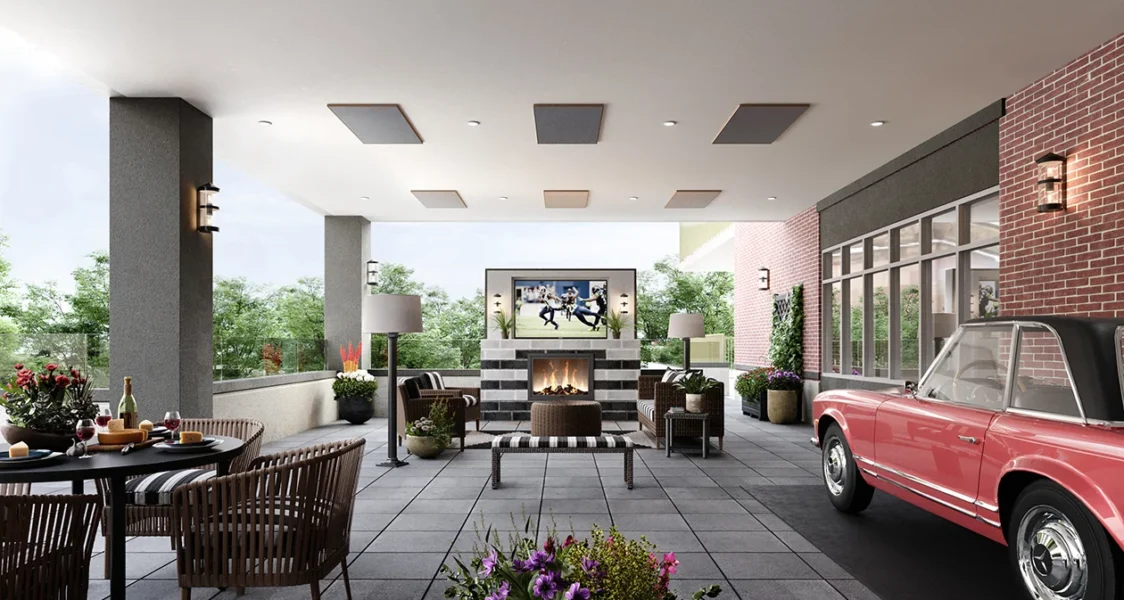The Evolution of Senior Living Design Trends
Discover how senior living design is transforming to enhance comfort and safety for our loved ones. Explore the latest trends and innovations that are shaping spaces where the elderly can thrive and feel at home. Read on to learn how thoughtfully considered design makes a real difference in senior living communities.

Senior housing has come a long way from its institutional roots, transforming into senior living spaces that feel more like homes filled with warmth and personal touches. This shift is driven by the recognition that where and how older adults live plays a critical role in their overall well-being. As lifestyles and expectations change among an aging population, so too does the approach to designing these communities.
Today, architects and designers focus on creating adaptable, aesthetically pleasing environments that cater to the physical and emotional needs of seniors whether they are active adults, or in need of more personalized care. Modern design for senior living communities aims to enhance residents’ quality of life by integrating features like better natural lighting, open spaces for social interaction, and advanced safety technologies. Recognizing these needs and meeting them through thoughtful senior living design is vital for elders’ well-being, and makes their daily lives safer, more comfortable, and joyous.
Trends in Senior Living Design–Then & Now
Historical Overview of Senior Living Communities
In the past, senior living communities prioritized basic care over comfort, often resembling hospitals more than homes. This old approach has transformed over the years. Now, senior living communities are designed to feel welcoming and warm, combining luxury elements with home-like comforts. This shift enhances not just safety but also the overall quality of life by making residents feel valued and respected, rather than just warehoused in nursing homes or a care facility.
Current Trends in Senior Living Design
Today, design for senior living communities focuses on elegant aesthetics blended with practical functionality. Modern communities boast open floor plans that are flexible for various activities, fostering both lively social interaction and peaceful solitude. Ample natural light, soothing color palettes, and advanced technology are integrated to support residents’ independence and wellness. Designers also prioritize eco-friendly materials and smart home features to create environments that are safe, sustainable, and adaptive to residents’ evolving needs.
Core Principles in Designing Senior Living Facilities
Safety and Accessibility
Safety and mobility are at the forefront of designing senior living communities, particularly when it is a memory care or assisted living facility. Features such as wide doorways and ramps instead of stairs ensure easy access for all, regardless of mobility level. Floors are chosen for their non-slip surfaces to reduce fall risks, and handrails line hallways and bathrooms for added support. Each room includes accessible emergency call systems, strategically placed to provide residents with the means to quickly seek help if necessary. These design elements foster a secure environment where residents can move freely and independently without worrying about their safety.
Comfort and Convenience
In modern senior living communities, comfort is integrated into every detail. From plush seating in common areas to adjustable lighting and climate controls in private spaces, every element is designed to make residents feel at ease. Amenities such as on-site salons, libraries, and dining venues are centrally located to reduce walking distances and support resident independence. The thoughtful placement of these facilities improves seniors’ overall living experience by ensuring that daily activities are convenient and enjoyable.
Safety and comfort are at the forefront of modern senior living community design. By integrating features such as non-slip floors, wide corridors, and step-free access, communities help ensure that their residents enjoy a secure and comfortable environment every day.
Innovations in Tech and Sustainability in Senior Living Design
Smart Home Technologies
Smart home technologies are transforming senior living communities by enhancing residents’ control over their environment. Automated systems like blinds that adjust according to daylight, thermostats that set room temperatures with precision, and lights that turn on with motion sensors improve daily comfort and reduce energy use. Additionally, voice-activated devices allow residents to manage settings, send messages, or summon assistance without physical strain. These tools and technologies not only make life easier but also foster independence and safety.
Sustainable and Eco-Friendly Designs
Sustainability is another trend that plays a critical role in the development of modern senior living communities. Buildings designed with recycled materials and outfitted with solar panels contribute to a reduced carbon footprint. Energy-efficient appliances and LED lighting cut down on power usage and operational costs. Green roofs and enhanced insulation improve air quality and help maintain temperature control. Sustainable building and design practices demonstrate a commitment to environmental stewardship while enhancing the living conditions for residents, and help make these communities both eco-friendly and economically viable in the long term.
Psychological Impact of Interior Design for Senior Living
Importance of Interior Design
Interior design profoundly influences both mental and physical health, and quality of life for residents in senior living communities. Thoughtful design can significantly reduce anxiety, enhance mood, and promote safety. For example, well-planned spaces with easy-to-navigate layouts and accessible furniture allow residents to move freely, reducing stress and the risk of falls. Well-designed environments support independence by boosting residents’ confidence and overall satisfaction.
Color Schemes and Natural Elements
The strategic use of color and natural elements in interior design plays a critical role in enhancing the well-being of seniors. Soft blues and greens create a calming atmosphere, while vibrant yellows bring energy and cheerfulness to common areas. Ample natural lighting is crucial; it not only improves visibility but also helps regulate sleep patterns and can boost mood. Incorporating plants and other natural materials can also enhance air quality and provide a sense of connection to the outdoors, further uplifting residents’ spirits and promoting health.
Community and Social Spaces in Senior Living
Designing for Social Interaction
For senior living communities, designing spaces that foster community building and encourage interaction is key. Dining halls, lounges, libraries, and outdoor gardens should be carefully laid out to make socializing natural and effortless. These communal areas are not just functional; they are vibrant hubs where residents can meet, share stories, and enjoy activities together. Communal spaces that can support a variety of social interactions, from large group events to smaller, more intimate gatherings, make it possible for all residents to find ways to connect with their community.
Private vs. Public Spaces
Achieving a balance between private and public spaces is essential in designing senior living communities. While private apartments provide a personal retreat for comfort and solitude, public areas are designed to foster a sense of community. These include features like varied seating options, soft ambient lighting, and thoughtful decor, which make communal areas welcoming yet spacious enough to prevent overcrowding. With careful planning and design, residents can engage with the community on their terms and enjoy opportunities for interaction while respecting their individual privacy needs.
Addressing Special Needs in Senior Living Design
Dementia-Friendly Design
Designing for residents with dementia involves specific details to enhance their daily life. This includes using clear signage with large, readable fonts and high-contrast colors to aid in navigation. Safe, enclosed outdoor spaces allow for interaction with nature while preventing wandering. Inside, non-slip floors reduce the risk of falls,and ample natural lighting helps reduce confusion and improve visibility. Personal touches like memory boxes outside doors help residents recognize their own space, enhancing their sense of comfort and security.
Adaptable Designs for Varied Health Needs
Adaptable design in senior living communities allows for living environments that can adjust as residents’ health conditions change, requiring different levels of care. This might involve installing grab bars in bathrooms, adjustable countertops in kitchens, and flexible lighting systems to accommodate varying levels of vision. Furniture and layouts are chosen to be easily reconfigured to suit mobility aids, and rooms are equipped with technology that monitors wellness and alerts staff to health changes. A resident’s needs will change as they move from independent living, to assisted living or skilled nursing care. Design teams should prioritize adaptable environments that can provide residents with safety and independence in keeping with their changing needs over time.
Practical Tips for Designing Senior Living Communities
Best Practices in Layout and Space Planning
Using space effectively is essential for creating welcoming and functional senior living communities. Designers should focus on clear, navigable pathways and open layouts that encourage both social interaction and individual privacy. Strategically place furniture and fixtures in a way that maximizes usability and accessibility, and makes movement easier for residents with varying mobility levels. For a balanced environment that caters to diverse needs, it’s also important to include quiet areas away from busier communal spaces, where residents can relax.
Considerations for Material and Finish Selections
Choosing the right materials and finishes is critical for a durable and aesthetically appealing design in senior living facilities. Surfaces should be easy to clean and maintain, resistant to wear and tear, and safe for all mobility levels. Flooring options like textured vinyl or rubber can prevent slips and falls. In living areas, soft-touch materials and warm, inviting colors can make spaces feel more like home. High-contrast colors can be beneficial in areas that require extra visibility for safety. Thoughtful attention to these details makes a community an inviting place to live, well-functioning, and safe place for residents to live.
Closing Thoughts
In recent years, senior living design has seen significant changes. Today’s communities prioritize safety, comfort, and the integration of smart technology. Designers focus on creating adaptable environments and senior living interiors that are both beautiful and functional, supporting a variety of health needs and lifestyle preferences. Natural elements and thoughtful color choices play a key role in enhancing the mood and health of residents.
As design continues to evolve to meet the changing needs of aging adults, this ongoing commitment to excellence ensures that our communities remain not only safe and comfortable but also vibrant places where seniors can truly enjoy their later years.
About Koelsch Communities
Since 1958, Koelsch Communities has been dedicated to providing exceptional, “Mom-approved” senior living and care across its communities. With a strong emphasis on creating safe, comfortable, and beautiful environments, we proudly see to it that every community meets the unique needs of its residents. Our hands-on approach and deep industry experience allow us to effectively oversee every detail, from design, to operations to the selection of amenities that enrich our residents’ lives. Contact us today to discover more about our commitment to excellence in senior care and how we can serve you and your family.









